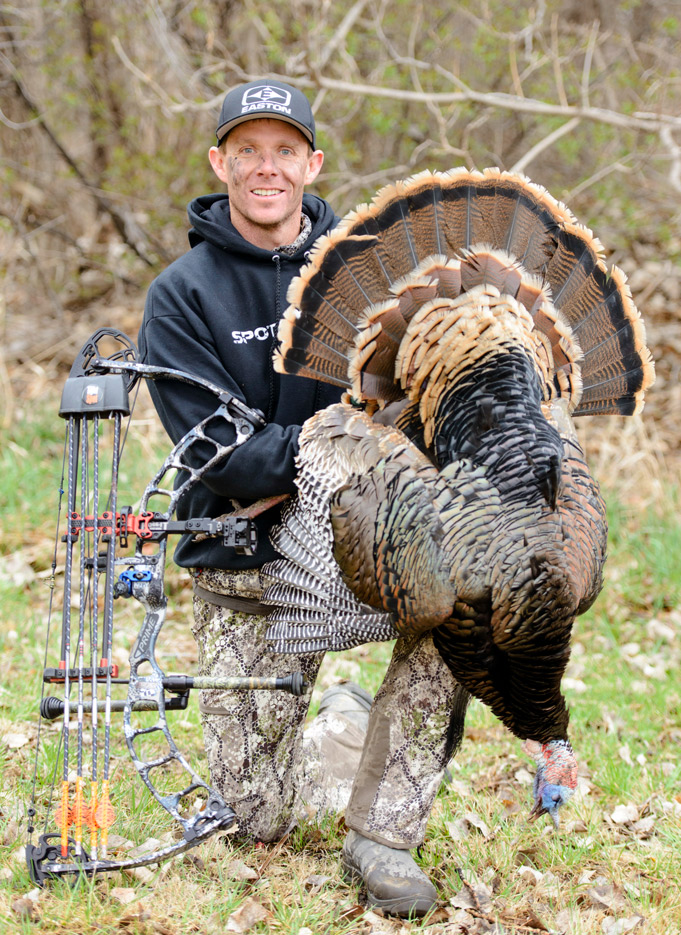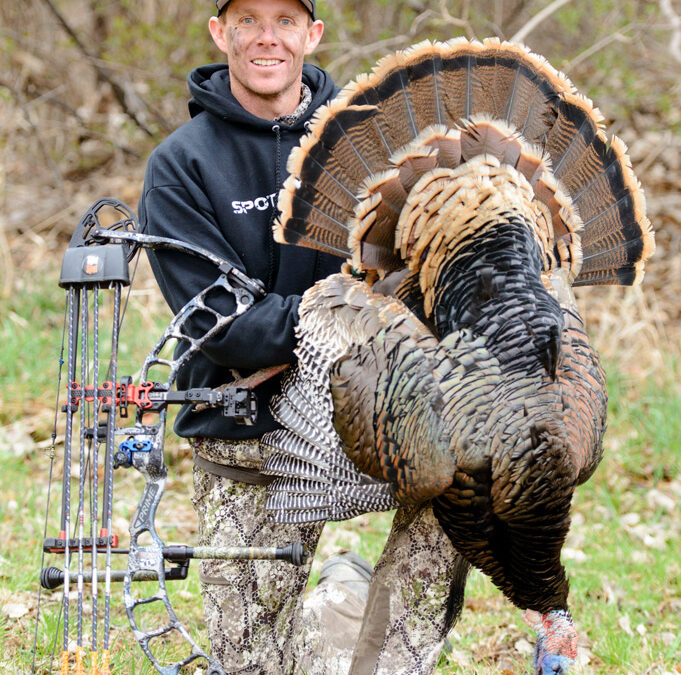
Are you really ready to put that arrow right where it needs to go this spring?
I could hear him. His spit-and-drum told me he was right behind the blind. My hands were
sweaty and my heart raced. I wanted to lift up the back window and peek out, but I knew
better. The hunt had been a grind. Mother Nature had been less than friendly, and the public
tracts I was accessing boasted low bird numbers. This was my chance, my one opportunity.
The long beard didn’t approach my jake or hen combo. Instead, he came around the blind and
walked between the window and my decoys, placed 13 yards away. He was close. The arrow
was gone quickly. Too quickly. I didn’t settle my pin. The second the illuminated green dot on
my sight hit feathers, I punched the release like Ali delivering a knockout blow. The arrow was
low and did nothing more than grab a few feathers before skipping across the open sage flat. I
was sick.
Too-Close Toms
I hunt springtime birds for the thrill. For me, few things rival the sound of a deafening gobble or
the sight of a ballooned-up long beard bumping up against my impostor jake. I’ve never had
issues getting turkeys in close. I trust my calls and my fakes. What I did struggle with early in my
turkey tenure was closing the deal.
Turkeys have small vitals, about the size of a softball. The margin for error is nil. I’d lay a pretty
good bet that more turkeys are hit and not recovered each year than all other game animals
combined. Nothing will make your stomach turn faster than watching a tom fly off with an
arrow or see it plop through him and watch him run for hundreds of yards out of sight.
How is this possible, especially when most of us set our decoys between 8 and 13 yards? For
starters, the birds are super close, which ushers in increased excitement. Our pin hits feather
and we let the arrow fly. Other times the birds are closer than top-pin close. At a distance of 5
yards, my 20-yard pin impacts the target 2 inches low. Practice has taught me that, at 5 yards, I
should use my 30-yard pin, or better yet, dial my single pin to 5 yards.
I love a single-pin sight for turkeys. Rarely do I take a shot past 20 yards, and by practicing
weeks before the season, I can dial-in a 5-yards-and-closer setting. In addition, I shoot the same
setup that I shoot 5-Spot indoor and 3-D tournaments with. I like a long axle-to-axle bow that is
perfectly weighted with a sidebar. Plus, I like a bow set at a smooth-drawing poundage —
nothing higher than 60 pounds. Turkeys don’t have thick bones, and although all those feathers
can thwart penetration, you don’t need much to get into the vitals. Personally, I would rather
see my arrow penetrate and stick in the bird than pass through. After months of shooting this
setup indoors and at some early 3-D shoots, it feels natural in the turkey woods. I’m used to burning my pin on 5-Spot targets and 12-rings on foam. My muscle memory kicks in, and before I know it, the shot is gone and the bird is flopping in the decoys.
Wrong Broadhead
Another reason for turkey woes is incorrect broadhead choice. Don’t opt for a small, fixed-
blade head. A mechanical with a big cutting surface has saved my bacon more than once. Heads
like G5’s DeadMeat are field-point accurate, and its three rear-deploying blades are wicked
sharp and carve a 1 ½-inch wound channel. For a larger cut expandable broadhead, try the all new MegaMeat 3 blade 2″ cut. Did You Practice That Shot?
I know 3-D targets are pricey, but a turkey target won’t break the bank. Take the time to set up
your blind and practice shooting a 3-D turkey out of a ground blind chair. It may sound a bit
elementary, but shooting from a chair, looking out through a blind window, feels different. Plus,
you need to know how well your pin glows inside a darkened blind. Putting arrow after arrow
into a 3-D turkey’s vitals boosts confidence.
Where Do I Shoot?
We know turkeys are lost to poor shot placement more than any other factor, and one question
that pops in my email inbox a lot throughout the year is, where do I shoot the bird? Well, here
you go.
• Facing Toward You
This is a tough shot, especially if the bird is in strut and full of air. The margin for error is
small, and you will want to make sure to focus your pin just above the bird’s beard. Hit
this spot, and the bird is dead. Miss high, and you have a good chance of hitting the
neck, which is also a fatal shot. Hit the bird much below the beard, and you will be in for
a long day.
• Facing Away From You
This is my favorite shot on a turkey when the bird is not in strut. Simply hold in the
middle of the bird’s back and execute. Your shot will often sever the spine and hit a
number of vital organs as it passes through and punches out the bird’s chest. If the bird
is in strut, the base of the fan offers an ideal aiming point. The arrow will pass through
the bird’s intestines and guts before continuing through the chest. A bird hit in the
“vent” won’t go far.
• Quartering Toward You
Turkeys don’t have heavy bones, and while we often shy away from quartering-to shots
on big game, we can go ahead and take a turkey at this angle. Simply draw a horizontal
line from the bird’s beard, then draw a vertical line up from the bird’s offside leg. When your vertical line intersects your horizontal line, you’re good. This shot will take out the bird’s heart, and if you hit high, your arrow will hit the spine. If the bird is in strut, move your horizontal line about two inches below the base of the neck and move your vertical line a few inches forward from the offside leg.
• Broadside
The main thing with this shot is focusing on not hitting the bird low. This happens a lot
when a turkey is in strut. It’s easy to hold low and execute the shot. Just remember, hit
em’ low and watch em’ go. If the bird is not in strut, focus on where the wing butt goes
into the body and come back from the wing butt about two inches. If the bird is in strut,
the crease you need to hit will be easily disguised in the upper-wing area.
• Head/Neck Shot
The cool thing about this shot is there is zero doubt about where to aim, and if you hit
the head or neck, the bird will drop in its tracks. The problem with this shot is that the
bird’s head will often be moving. Make sure the head is still before executing your shot.

